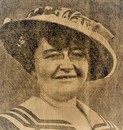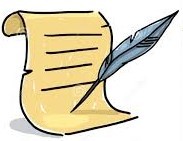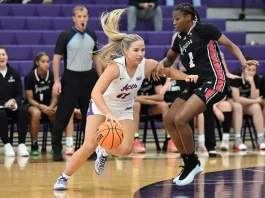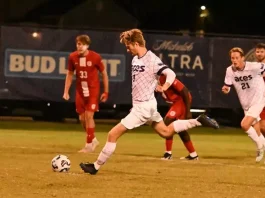
150 YEARS AGO
1871   Indianapolis Mayor Daniel McCauley announced that City Marshall George Taffe would be rigidly enforcing the hog ordinance. Swine of all description would be prohibited from roaming at large in the city “no matter whether they have rings in their noses or not.” A notice in the Evening News stated that “owners are hereby notified that the authorities are in earnest and if they would ‘save their bacon’ they must shut up their hogs or Marshall Taffe will save them the trouble.”
|

100 YEARS AGO
1921   Burglars used nitroglycerin to blow open the safe at the Rushville Post Office. Postmaster G. P. Hunt found that the crooks had taken $10,000 worth of stamps. Newspaper accounts said that detectives had few clues, other than a soft felt hat and some tools left behind by the “yeggmen.” A citizen reported hearing an explosion between midnight and 1:00 am the night before. Pictured: The 2-cent first class stamp in 1921.
|

MARCH IS WOMEN’S HISTORY MONTH
1926   Esther Griffin White, Richmond, Indiana, filed papers with the Secretary of State to run for election as Representative in the Sixth Congressional District. Active in the political arena, she had been a delegate at the 1920 Republican State Convention. When she ran for the Congressional seat, she was the first Indiana woman to do so. She ran for Congress again in 1928. Twice a candidate for mayor of Richmond, she never won a political office, although she worked hard to encourage the involvement of women in governmental affairs. A long-time journalist, she wrote for several local newspapers and sometimes published her own,The Little Paper.  An energetic social activist, suffragist, and defender of minorities and the downtrodden, Esther Griffin White was inducted posthumously into the Indiana Journalism Hall of Fame in 1992. |
 1935   The Rural Electric Membership Corporation (REMC) was created by the Indiana General Assembly. At the time, less than 10 percent of rural America had access to electrical power. The legislation, signed by Governor Paul V. McNutt, made it possible, in conjunction with the federal government, to provide loans to utility companies which would enable them to extend power lines to farms and homes “out in the country.” 1935   The Rural Electric Membership Corporation (REMC) was created by the Indiana General Assembly. At the time, less than 10 percent of rural America had access to electrical power. The legislation, signed by Governor Paul V. McNutt, made it possible, in conjunction with the federal government, to provide loans to utility companies which would enable them to extend power lines to farms and homes “out in the country.” |
 1963   The Indiana General Assembly voted to adopt “Indiana,” by Arthur Franklin Mapes, as the official state poem. Mapes, a long-time resident of Kendallville, was a machinist whose hobby was writing poetry. During his career, he was honored with numerous awards on the state, national, and international level. He often wrote about his hometown and state and the beauty of nature. 1963   The Indiana General Assembly voted to adopt “Indiana,” by Arthur Franklin Mapes, as the official state poem. Mapes, a long-time resident of Kendallville, was a machinist whose hobby was writing poetry. During his career, he was honored with numerous awards on the state, national, and international level. He often wrote about his hometown and state and the beauty of nature. |

50 YEARS AGO
1971   Comedian, author, and social activist Dick Gregory was on stage at the Murat Theater in Indianapolis. He was part of a program sponsored by the Black Student Union at Indiana-Purdue University in the city. Joking and serious at the same time about current events and racism in America, he praised the new generation, calling them “the most morally honest, dedicated group of young people this country has ever seen.”
|

Abe Martin Sez: It’s what we learn after we think we know it all that counts. (Kin Hubbard, Indianapolis News, March 7, 1923) |
Follow this link to subscribe to Hoosier History Highlights and to view archived editions
Follow us on Instagram: @instatehousetouroffice
|





 1935   The Rural Electric Membership Corporation (REMC) was created by the Indiana General Assembly. At the time, less than 10 percent of rural America had access to electrical power. The legislation, signed by Governor Paul V. McNutt, made it possible, in conjunction with the federal government, to provide loans to utility companies which would enable them to extend power lines to farms and homes “out in the country.”
1935   The Rural Electric Membership Corporation (REMC) was created by the Indiana General Assembly. At the time, less than 10 percent of rural America had access to electrical power. The legislation, signed by Governor Paul V. McNutt, made it possible, in conjunction with the federal government, to provide loans to utility companies which would enable them to extend power lines to farms and homes “out in the country.” 1963   The Indiana General Assembly voted to adopt “Indiana,” by Arthur Franklin Mapes, as the official state poem. Mapes, a long-time resident of Kendallville, was a machinist whose hobby was writing poetry. During his career, he was honored with numerous awards on the state, national, and international level. He often wrote about his hometown and state and the beauty of nature.
1963   The Indiana General Assembly voted to adopt “Indiana,” by Arthur Franklin Mapes, as the official state poem. Mapes, a long-time resident of Kendallville, was a machinist whose hobby was writing poetry. During his career, he was honored with numerous awards on the state, national, and international level. He often wrote about his hometown and state and the beauty of nature.






